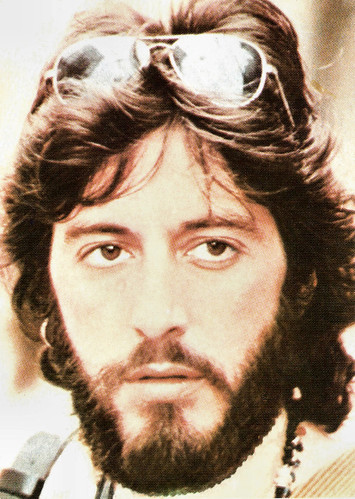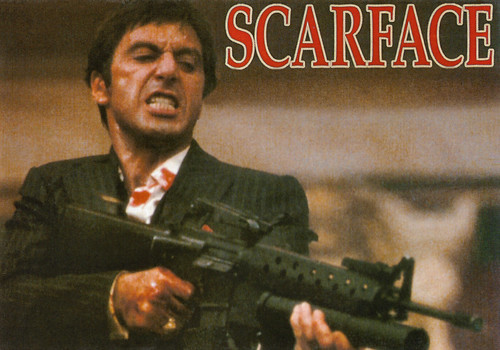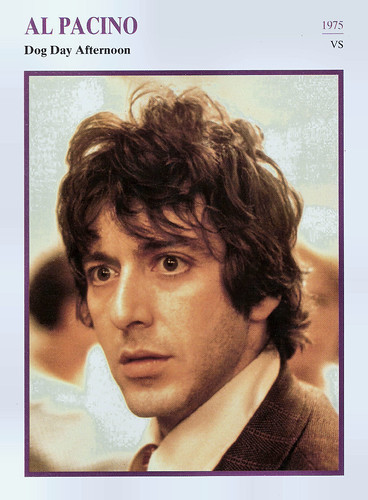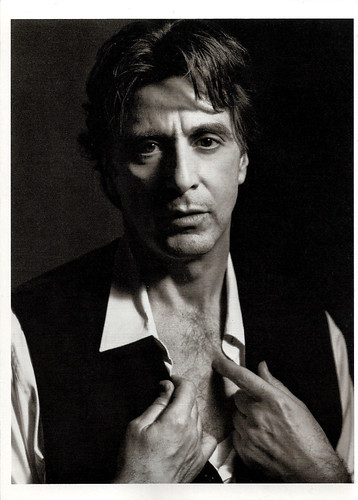During the 1970s, American actor Al Pacino (1940) established himself with such films as The Godfather (1972), Serpico (1973), The Godfather: Part II (1974) and Dog Day Afternoon (1975). In the following decades, he became an enduring icon of the American cinema. He won the Triple Crown of Acting: an Oscar for Best Actor for Scent of a Woman (1992); a Tony for Best Supporting Actor in the play 'Does a Tiger Wear a Necktie?' (1969) and for Best Actor in the play 'The Basic Training of Pavlo Hummel' (1977); and an Emmy for Best Actor in the Miniseries Angels in America (2003).

British postcard by Star-Graphics, no. S 89. Photo: Al Pacino in The Godfather (Francis Ford Coppola, 1972).

British postcard by Star-Graphics, no. S 91. Photo: Al Pacino and Marlon Brando in The Godfather (Francis Ford Coppola, 1972).

French postcard in the Collection In Cinéma by Editions La Malibran, Paris / Nancy, 1989, no. CA 51. Photo: Al Pacino in Scarecrow (Jerry Schatzberg, 1973).
Alfredo James 'Al' Pacino was born in 1940 in Manhattan, New York City, to Italian-American parents, Rose (nee Gerardi) and Sal Pacino, who worked as an insurance agent. His maternal grandfather was born in Corleone, Sicily. His parents divorced when he was two years old.
His mother moved them into his grandparents' home in the South Bronx. In his teenage years, Pacino was known as 'Sonny' to his friends. Pacino found himself often repeating the plots and voices of characters he had seen in films. Bored and unmotivated in school, he found a haven in school plays, and his interest soon blossomed into a full-time career.
He attended the High School of the Performing Arts until he dropped out at age 17. In 1962, Pacino's mother died at the age of 43. The following year, his grandfather James also died. Starting on stage, he went through a period of depression and poverty, sometimes having to borrow bus fare to succeed to auditions. He made it into the prestigious Actors Studio in 1966, studying under Lee Strasberg, creator of the Method Approach that would become the trademark of many 1970s-era actors.
After appearing in a string of plays in supporting roles, Pacino finally attained success off-Broadway with Israel Horovitz's 'The Indian Wants the Bronx', winning an Obie Award for the 1966-1967 season. He was also nominated for a Best Actor Obie for 'Why Is a Crooked Letter' (1966). That was followed by a Tony Award for 'Does the Tiger Wear a Necktie?'
Pacino was a longtime member of David Wheeler's Theatre Company of Boston, for which he performed in 'Richard III' in Boston (1972-1973) and at the Cort Theater in New York City (1979). He also appeared in their productions of Bertolt Brecht's 'Arturo Ui' at the Charles Theater in Boston in 1975 and later in New York and London, and in David Rabe's 'The Basic Training of Pavlo Hummel' at the Longacre Theater in New York in 1977.
At the age of 29 he made his film debut with a supporting part in Me, Natalie (Fred Coe, 1969) featuring Patty Duke. In 1970, Pacino signed with the talent agency Creative Management Associates (CMA). He gained favourable notice for his first lead role as a heroin addict in The Panic in Needle Park (Jerry Schatzberg, 1971). These first feature films made a little departure from the gritty realistic stage performances that earned him respect.
Then came the role of Michael Corleone in The Godfather (Francis Ford Coppola, 1972). It was one of the most sought-after of the time: Robert Redford, Warren Beatty, Jack Nicholson, Ryan O'Neal, Robert De Niro and a host of other actors either wanted it or were mentioned. Pacino was rejected repeatedly by studio heads for the role, but Francis Ford Coppola fought for him. Coppola was successful but Pacino was reportedly in constant fear of being fired during the very difficult shoot. Ironically, The Godfather (1972) was a monster hit that earned Pacino his first Academy Award nomination for Best Supporting Actor. It turned out to be the breakthrough for both Pacino and director Francis Ford Coppola.

French postcard by Travelling Editions, Paris, no. CP7. Photo: Al Pacino in Scarecrow (Jerry Schatzberg, 1973).

Romanian postcard by Casa Filmului Acin. Photo: Al Pacino in Scarecrow (Jerry Schatzberg, 1973).

Romanian postcard by Casa Filmului Acin. Photo: Al Pacino in Serpico (Sidney Lumet, 1973).
Instead of taking on easier projects for the big money after this success, Al Pacino threw his support behind what he considered tough but important films. In 1973, Pacino co-starred in Scarecrow (Jerry Schatzberg, 1973), with Gene Hackman, and won the Palme d'Or at the Cannes Film Festival.
He also starred in the true-life crime drama Serpico (Sidney Lumet, 1973) and the tragic real-life bank robbery film Dog Day Afternoon (Sidney Lumet, 1975). In between, he returned as Michael Corleone in The Godfather: Part II (Francis Ford Coppola, 1974), the first sequel ever to win the Best Picture Oscar. For these three films, Pacino was nominated three consecutive years for the Best Actor Academy Award.
In 1977, he won his second Tony Award as Best Actor (Play) for 'The Basic Training of Pavlo Hummel' (1977). He faltered slightly with Bobby Deerfield (Sydney Pollack, 1977), but regained his stride with ...and justice for all. (Norman Jewison, 1979), for which he received another Academy Award nomination for Best Actor.
Unfortunately, this would signal the beginning of a decline in his career, which produced flops like the controversial Cruising (William Friedkin, 1980), and the comedy-drama Author! Author! (Arthur Hiller, 1982), with Dyan Cannon and Tuesday Weld.
Pacino cemented his legendary status with his role as Cuban drug lord Tony Montana in the ultra-violent cult film Scarface (Brian De Palma, 1983), with Michelle Pfeiffer and Steven Bauer. Keith Phipps at AllMovie: "Infinitely quotable and more than a little cartoonish, Brian De Palma's update of Howard Hawks' seminal gangster film revels in its freedom to be larger than life. A work as akin to pop art as any other form, it reworks the crime melodrama in bold, primary colors, mostly blood red. Attracting a great deal of attention for its violence at the time of its release, the controversy overshadowed the fact that everything in the film ran to extremes, including Pacino's performance, the director's visual style (which found him almost reverting to The Fury mode), the dialogue (from a script co-written by Oliver Stone), and most importantly the themes. "
Pedro Borges at IMDb: "a monumental mistake was about to follow. Revolution (Hugh Hudson, 1985) endured an endless and seemingly cursed shoot in which equipment was destroyed, the weather was terrible, and Pacino fell ill with pneumonia. Constant changes in the script further derailed the project. The Revolutionary War-themed film, considered among the worst films ever made, resulted in awful reviews and kept him off the screen for the next four years."
Returning to the stage, Pacino did much to give back and contribute to the theatre, which he considers his first love. He directed a film, The Local Stigmatic (1990), but it remains unreleased. He lifted his self-imposed exile playing a hard-drinking policeman in the striking Sea of Love (Harold Becker, 1989), with Ellen Barkin. This marked the second phase of Pacino's career, being the first to feature his now famous dark, owl eyes, and hoarse, gravelly voice.

Big postcard by Pyramid Posters, Leicester, no. SPC9608. Photo: Universal Studios. Al Pacino in Scarface (Brian De Palma, 1983).

Postcard, no. C120. Photo: poster for Scarface (Brian De Palma, 1983). Collection: Daniël van der Aa.

French postcard. Photo: Universal Studios. Al Pacino in Scarface (Brian De Palma, 1983).
Returning to the Corleones, Al Pacino made The Godfather: Part III (Francis Ford Coppola, 1990) and earned raves for his first comedic role in the colourful adaptation Dick Tracy (Warren Beatty, 1990). This earned him another Academy Award nomination for Best Supporting Actor, and two years later he was nominated for Glengarry Glen Ross (James Foley, 1992).
He went into romantic mode for Frankie and Johnny (Garry Marshall, 1991) with Michelle Pfeiffer. In 1992, he finally won the Academy Award for Best Actor for his amazing performance as the blind U.S. Army Lieutenant Colonel Frank Slade in Scent of a Woman (Martin Brest, 1992). A mixture of technical perfection and charisma, the role was tailor-made for him and remains a classic.
The next few years would see Pacino becoming more comfortable with acting and films as a business, turning out great roles in great films with more frequency and less of the demanding personal involvement of his wilder days. Carlito's Way (Brian De Palma, 1993) with Sean Penn proved another gangster classic, as did the epic crime drama Heat (Michael Mann, 1995) co-starring Robert De Niro.
He directed the theatrical docudrama Looking for Richard (1996), a performance of selected scenes of William Shakespeare's 'Richard III' and a broader examination of Shakespeare's continuing role and relevance in popular culture. In Donnie Brasco (Mike Newell, 1997), Pacino played gangster 'Lefty' in the true story of undercover FBI agent Donnie Brasco (Johnny Depp) and his work in bringing down the Mafia from the inside.
Pacino played Satan in the supernatural thriller The Devil's Advocate (Taylor Hackford, 1997) which co-starred Keanu Reeves. The film was a success at the box office, taking US$150 million worldwide. He also gave commanding performances in The Insider (Michael Mann, 1999) with Russell Crowe, and Any Given Sunday (Oliver Stone, 1999) opposite Cameron Diaz.

Dutch postcard by Boomerang, Amsterdam. Photo: Al Pacino in Carlito's Way (Brian De Palma, 1993).
Al Pacino co-starred with Hillary Swank and Robin Williams in the mystery thriller Insomnia (Christopher Nolan, 2002), a remake of the Norwegian film of the same name. Pacino starred as Shylock in Michael Radford's film adaptation of The Merchant of Venice (2004), choosing to bring compassion and depth to a character traditionally played as a villainous caricature.
In the 2000s, he starred in a number of theatrical blockbusters, including Ocean's Thirteen (Steven Soderbergh, 2007) with George Clooney and Brad Pitt, but his choice in television roles like the vicious, closeted Roy Cohn in the HBO miniseries Angels in America (Tony Kushner, 2003) and his sensitive portrayal of Jack Kevorkian, in the television film You Don't Know Jack (Barry Levinson, 2010), are reminiscent of the bolder choices of his early career. Each television project garnered him an Emmy Award for Outstanding Lead Actor in a Miniseries or a Movie.
Recently, Pacino starred alongside Brad Pitt and Leonardo DiCaprio in Quentin Tarantino's comedy-drama Once Upon a Time in Hollywood (2019) and he co-starred with Robert De Niro in Martin Scorsese's Netflix film The Irishman (2019). He will play Meyer Offerman, a fictional Nazi hunter, in the Amazon Video series Hunters.
Never wed, Pacino has a daughter, Julie Marie, with acting teacher Jan Tarrant, and a set of twins with former longtime girlfriend Beverly D'Angelo. His romantic history includes Veruschka von Lehndorff, Jill Clayburgh, Debra Winger, Tuesday Weld, Marthe Keller, Carmen Cervera, Kathleen Quinlan, Lyndall Hobbs, Penelope Ann Miller, and a two-decade intermittent relationship with Godfather co-star Diane Keaton.
Since 2007, Al Pacino lives with Argentinian actress Lucila Solá, who is 36 years his junior. In 2007, the American Film Institute awarded Pacino with a lifetime achievement award.

Dutch collectors card in the series 'Filmsterren: een Portret' by Edito Service, 1993. Photo: Stars-Films. Al Pacino in Dog Day Afternoon (Sidney Lumet, 1975).

American postcard by Fotofolio, New York, no. HR73. Photo: Herb Ritts. Caption: Al Pacino, New York City, 1992.
Sources: Keith Phipps (AllMovie), Pedro Borges (IMDb), Wikipedia and IMDb.

British postcard by Star-Graphics, no. S 89. Photo: Al Pacino in The Godfather (Francis Ford Coppola, 1972).

British postcard by Star-Graphics, no. S 91. Photo: Al Pacino and Marlon Brando in The Godfather (Francis Ford Coppola, 1972).

French postcard in the Collection In Cinéma by Editions La Malibran, Paris / Nancy, 1989, no. CA 51. Photo: Al Pacino in Scarecrow (Jerry Schatzberg, 1973).
Michael Corleone
Alfredo James 'Al' Pacino was born in 1940 in Manhattan, New York City, to Italian-American parents, Rose (nee Gerardi) and Sal Pacino, who worked as an insurance agent. His maternal grandfather was born in Corleone, Sicily. His parents divorced when he was two years old.
His mother moved them into his grandparents' home in the South Bronx. In his teenage years, Pacino was known as 'Sonny' to his friends. Pacino found himself often repeating the plots and voices of characters he had seen in films. Bored and unmotivated in school, he found a haven in school plays, and his interest soon blossomed into a full-time career.
He attended the High School of the Performing Arts until he dropped out at age 17. In 1962, Pacino's mother died at the age of 43. The following year, his grandfather James also died. Starting on stage, he went through a period of depression and poverty, sometimes having to borrow bus fare to succeed to auditions. He made it into the prestigious Actors Studio in 1966, studying under Lee Strasberg, creator of the Method Approach that would become the trademark of many 1970s-era actors.
After appearing in a string of plays in supporting roles, Pacino finally attained success off-Broadway with Israel Horovitz's 'The Indian Wants the Bronx', winning an Obie Award for the 1966-1967 season. He was also nominated for a Best Actor Obie for 'Why Is a Crooked Letter' (1966). That was followed by a Tony Award for 'Does the Tiger Wear a Necktie?'
Pacino was a longtime member of David Wheeler's Theatre Company of Boston, for which he performed in 'Richard III' in Boston (1972-1973) and at the Cort Theater in New York City (1979). He also appeared in their productions of Bertolt Brecht's 'Arturo Ui' at the Charles Theater in Boston in 1975 and later in New York and London, and in David Rabe's 'The Basic Training of Pavlo Hummel' at the Longacre Theater in New York in 1977.
At the age of 29 he made his film debut with a supporting part in Me, Natalie (Fred Coe, 1969) featuring Patty Duke. In 1970, Pacino signed with the talent agency Creative Management Associates (CMA). He gained favourable notice for his first lead role as a heroin addict in The Panic in Needle Park (Jerry Schatzberg, 1971). These first feature films made a little departure from the gritty realistic stage performances that earned him respect.
Then came the role of Michael Corleone in The Godfather (Francis Ford Coppola, 1972). It was one of the most sought-after of the time: Robert Redford, Warren Beatty, Jack Nicholson, Ryan O'Neal, Robert De Niro and a host of other actors either wanted it or were mentioned. Pacino was rejected repeatedly by studio heads for the role, but Francis Ford Coppola fought for him. Coppola was successful but Pacino was reportedly in constant fear of being fired during the very difficult shoot. Ironically, The Godfather (1972) was a monster hit that earned Pacino his first Academy Award nomination for Best Supporting Actor. It turned out to be the breakthrough for both Pacino and director Francis Ford Coppola.

French postcard by Travelling Editions, Paris, no. CP7. Photo: Al Pacino in Scarecrow (Jerry Schatzberg, 1973).

Romanian postcard by Casa Filmului Acin. Photo: Al Pacino in Scarecrow (Jerry Schatzberg, 1973).

Romanian postcard by Casa Filmului Acin. Photo: Al Pacino in Serpico (Sidney Lumet, 1973).
Three consecutive Oscar nominations
Instead of taking on easier projects for the big money after this success, Al Pacino threw his support behind what he considered tough but important films. In 1973, Pacino co-starred in Scarecrow (Jerry Schatzberg, 1973), with Gene Hackman, and won the Palme d'Or at the Cannes Film Festival.
He also starred in the true-life crime drama Serpico (Sidney Lumet, 1973) and the tragic real-life bank robbery film Dog Day Afternoon (Sidney Lumet, 1975). In between, he returned as Michael Corleone in The Godfather: Part II (Francis Ford Coppola, 1974), the first sequel ever to win the Best Picture Oscar. For these three films, Pacino was nominated three consecutive years for the Best Actor Academy Award.
In 1977, he won his second Tony Award as Best Actor (Play) for 'The Basic Training of Pavlo Hummel' (1977). He faltered slightly with Bobby Deerfield (Sydney Pollack, 1977), but regained his stride with ...and justice for all. (Norman Jewison, 1979), for which he received another Academy Award nomination for Best Actor.
Unfortunately, this would signal the beginning of a decline in his career, which produced flops like the controversial Cruising (William Friedkin, 1980), and the comedy-drama Author! Author! (Arthur Hiller, 1982), with Dyan Cannon and Tuesday Weld.
Pacino cemented his legendary status with his role as Cuban drug lord Tony Montana in the ultra-violent cult film Scarface (Brian De Palma, 1983), with Michelle Pfeiffer and Steven Bauer. Keith Phipps at AllMovie: "Infinitely quotable and more than a little cartoonish, Brian De Palma's update of Howard Hawks' seminal gangster film revels in its freedom to be larger than life. A work as akin to pop art as any other form, it reworks the crime melodrama in bold, primary colors, mostly blood red. Attracting a great deal of attention for its violence at the time of its release, the controversy overshadowed the fact that everything in the film ran to extremes, including Pacino's performance, the director's visual style (which found him almost reverting to The Fury mode), the dialogue (from a script co-written by Oliver Stone), and most importantly the themes. "
Pedro Borges at IMDb: "a monumental mistake was about to follow. Revolution (Hugh Hudson, 1985) endured an endless and seemingly cursed shoot in which equipment was destroyed, the weather was terrible, and Pacino fell ill with pneumonia. Constant changes in the script further derailed the project. The Revolutionary War-themed film, considered among the worst films ever made, resulted in awful reviews and kept him off the screen for the next four years."
Returning to the stage, Pacino did much to give back and contribute to the theatre, which he considers his first love. He directed a film, The Local Stigmatic (1990), but it remains unreleased. He lifted his self-imposed exile playing a hard-drinking policeman in the striking Sea of Love (Harold Becker, 1989), with Ellen Barkin. This marked the second phase of Pacino's career, being the first to feature his now famous dark, owl eyes, and hoarse, gravelly voice.

Big postcard by Pyramid Posters, Leicester, no. SPC9608. Photo: Universal Studios. Al Pacino in Scarface (Brian De Palma, 1983).

Postcard, no. C120. Photo: poster for Scarface (Brian De Palma, 1983). Collection: Daniël van der Aa.

French postcard. Photo: Universal Studios. Al Pacino in Scarface (Brian De Palma, 1983).
Playing Satan
Returning to the Corleones, Al Pacino made The Godfather: Part III (Francis Ford Coppola, 1990) and earned raves for his first comedic role in the colourful adaptation Dick Tracy (Warren Beatty, 1990). This earned him another Academy Award nomination for Best Supporting Actor, and two years later he was nominated for Glengarry Glen Ross (James Foley, 1992).
He went into romantic mode for Frankie and Johnny (Garry Marshall, 1991) with Michelle Pfeiffer. In 1992, he finally won the Academy Award for Best Actor for his amazing performance as the blind U.S. Army Lieutenant Colonel Frank Slade in Scent of a Woman (Martin Brest, 1992). A mixture of technical perfection and charisma, the role was tailor-made for him and remains a classic.
The next few years would see Pacino becoming more comfortable with acting and films as a business, turning out great roles in great films with more frequency and less of the demanding personal involvement of his wilder days. Carlito's Way (Brian De Palma, 1993) with Sean Penn proved another gangster classic, as did the epic crime drama Heat (Michael Mann, 1995) co-starring Robert De Niro.
He directed the theatrical docudrama Looking for Richard (1996), a performance of selected scenes of William Shakespeare's 'Richard III' and a broader examination of Shakespeare's continuing role and relevance in popular culture. In Donnie Brasco (Mike Newell, 1997), Pacino played gangster 'Lefty' in the true story of undercover FBI agent Donnie Brasco (Johnny Depp) and his work in bringing down the Mafia from the inside.
Pacino played Satan in the supernatural thriller The Devil's Advocate (Taylor Hackford, 1997) which co-starred Keanu Reeves. The film was a success at the box office, taking US$150 million worldwide. He also gave commanding performances in The Insider (Michael Mann, 1999) with Russell Crowe, and Any Given Sunday (Oliver Stone, 1999) opposite Cameron Diaz.

Dutch postcard by Boomerang, Amsterdam. Photo: Al Pacino in Carlito's Way (Brian De Palma, 1993).
Once Upon a Time in Hollywood
Al Pacino co-starred with Hillary Swank and Robin Williams in the mystery thriller Insomnia (Christopher Nolan, 2002), a remake of the Norwegian film of the same name. Pacino starred as Shylock in Michael Radford's film adaptation of The Merchant of Venice (2004), choosing to bring compassion and depth to a character traditionally played as a villainous caricature.
In the 2000s, he starred in a number of theatrical blockbusters, including Ocean's Thirteen (Steven Soderbergh, 2007) with George Clooney and Brad Pitt, but his choice in television roles like the vicious, closeted Roy Cohn in the HBO miniseries Angels in America (Tony Kushner, 2003) and his sensitive portrayal of Jack Kevorkian, in the television film You Don't Know Jack (Barry Levinson, 2010), are reminiscent of the bolder choices of his early career. Each television project garnered him an Emmy Award for Outstanding Lead Actor in a Miniseries or a Movie.
Recently, Pacino starred alongside Brad Pitt and Leonardo DiCaprio in Quentin Tarantino's comedy-drama Once Upon a Time in Hollywood (2019) and he co-starred with Robert De Niro in Martin Scorsese's Netflix film The Irishman (2019). He will play Meyer Offerman, a fictional Nazi hunter, in the Amazon Video series Hunters.
Never wed, Pacino has a daughter, Julie Marie, with acting teacher Jan Tarrant, and a set of twins with former longtime girlfriend Beverly D'Angelo. His romantic history includes Veruschka von Lehndorff, Jill Clayburgh, Debra Winger, Tuesday Weld, Marthe Keller, Carmen Cervera, Kathleen Quinlan, Lyndall Hobbs, Penelope Ann Miller, and a two-decade intermittent relationship with Godfather co-star Diane Keaton.
Since 2007, Al Pacino lives with Argentinian actress Lucila Solá, who is 36 years his junior. In 2007, the American Film Institute awarded Pacino with a lifetime achievement award.

Dutch collectors card in the series 'Filmsterren: een Portret' by Edito Service, 1993. Photo: Stars-Films. Al Pacino in Dog Day Afternoon (Sidney Lumet, 1975).

American postcard by Fotofolio, New York, no. HR73. Photo: Herb Ritts. Caption: Al Pacino, New York City, 1992.
Sources: Keith Phipps (AllMovie), Pedro Borges (IMDb), Wikipedia and IMDb.
No comments:
Post a Comment